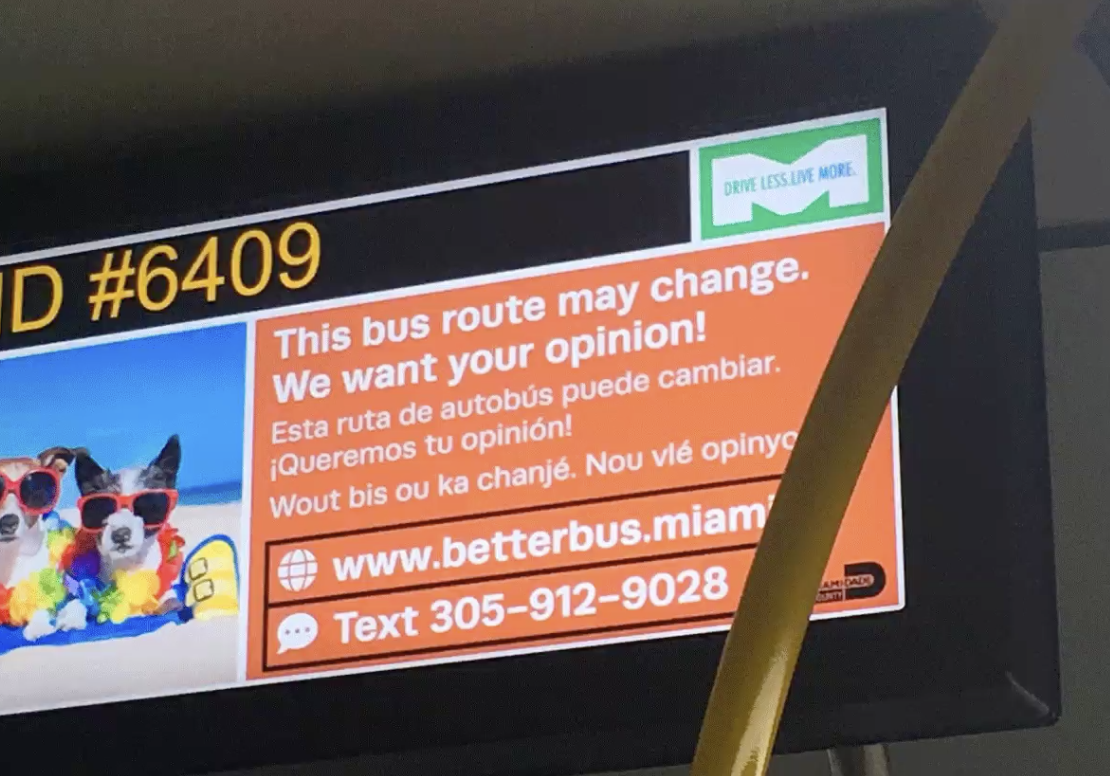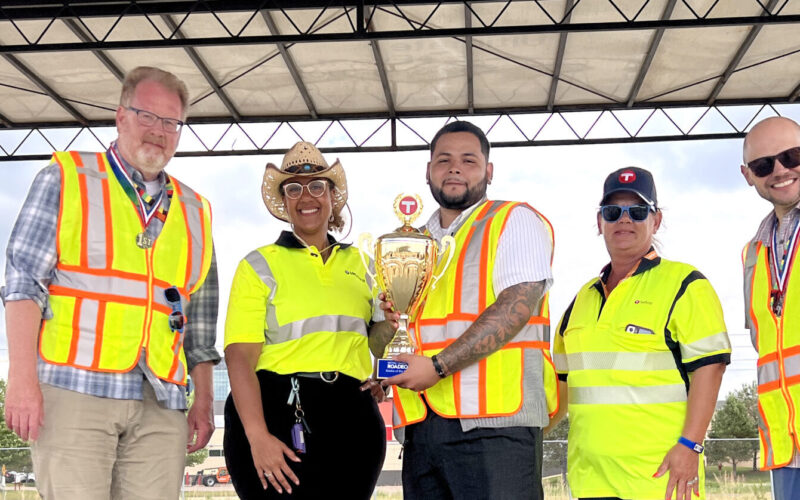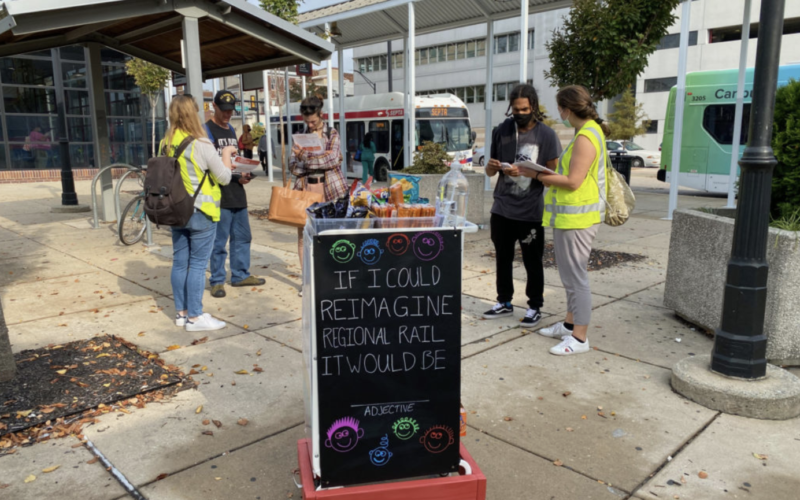
Transit Alliance Miami uses a text hotline to educate riders about Miami's bus network redesign
COVID-19-related moratoriums on public gatherings have inevitably affected the public engagement process for transit projects. Transportation consultants and advocates are already adapting to keep rider-focused initiatives like bus network redesigns moving forward.
Compared to typical engagement methods like public meetings, some of the strategies they’re deploying – like telephone town halls and text hotlines – are improving access and providing participants with more flexibility. While concerns over the digital divide remain, their efforts are demonstrating that it’s possible to meet people where they are, even with the current restrictions in place.
Before the pandemic hit, Transit Alliance Miami was conducting public engagement for Miami- Dade Transit’s bus network redesign, which kicked off in June 2019. Much of the outreach consisted of sending staff members to transit stations and stops to ask people if they’d like to learn about the redesign and take a survey.
Now Transit Alliance has shifted to a novel yet accessible solution it developed before COVID-19 – a hotline for riders to text to get information about the redesign. “We have a sign in every Miami bus as well as in some of the trolleys that says, ‘Your route may change, text this number,’” says Executive Director Az Chougle.
So far, this service has resulted in 4,400 unique text exchanges between Transit Alliance staff and Miami transit riders about the concepts of the network redesign. Riders are also directed to the survey, where they can express preferences like whether the redesign should focus on providing more frequent service or covering a larger geographic area.
With the text service, Transit Alliance can reach a broad array of transit riders as they use the system – “the people who are affected the most by service changes, versus the people who have time to show up to a public meeting,” Chougle says. The best part about it, he adds, is the extremely low barrier to entry – all someone needs is a cell phone, not even a data plan. And while it requires a fair amount of staff time, Chougle sees no reason the model can’t be replicated by transit agencies everywhere.
In Dallas, DART is also in the midst of a bus network redesign. Michelle Poyourow, a transit planner with the firm Jarrett Walker and Associates, originally intended to conduct three types of outreach for the project – in-person public meetings, intercept surveys, and webinars. Only the webinars have moved forward.
So far DART has hosted two webinars to inform Dallas transit riders about the redesign and get feedback through a survey. Compared to public meetings where everyone has to attend at the same location, the webinars elicit more participation, says Poyourow. “We’ve had 200 people engage for an hour – a pretty substantial commitment of their time, which is a higher number of people than I would expect to see at public workshops.”
Poyourow is working to make DART’s online outreach more inclusive. “We’ve done three telephone town halls, offered in English and Spanish, that enabled people to call in, and I was pleasantly surprised by how many people that did.” Several people identified themselves as having a disability during the town halls, and holding the events over the phone enabled them to participate without “software that involves lots and lots of typing,” Poyourow says. She has also hosted a Facebook Live event with DART staff, and is developing a web-based workshop format that will include a game, breakout discussions, and polling to better mimic the experience of being in a room with other people.
While the online events seem to draw a more engaged, racially diverse audience than typical public workshops, Poyourow remains acutely aware that many riders don’t have the time and access to spend an hour on a transportation webinar. “I want to consult the people who are most vulnerable and who use the system the most,” she said. “And right now, they’re also the hardest to reach.”
Her plan is to eventually survey DART riders in person, the type of engagement for which she says there’s no substitute. “There’s actually a lot of people still riding DART, and we do want to talk with them, but we’ve been waiting until it’s actually appropriate to go out and have that kind of almost face-to-face contact with people.” She’s uncertain what this will look like and whether riders will respond well to surveyors wearing masks.
Chougle is also cautious about sending his team back out to the street. “I can’t reasonably say ‘out you go’ to my staff – there’s a pandemic going on.” That’s why continuing to expand virtual engagement will be critical to Transit Alliance Miami’s strategy.
Chougle plans to convene online meetings with stakeholders that are currently wondering what role transit will play in the recovery, such as the Miami Chamber of Commerce. He’s also assigned one member of his team to scan social media for people who are tweeting about transit, and to initiate a conversation with them about the work Transit Alliance is doing around the redesign. “You’ve got to reach into all the pots to do what you can while keeping people safe.”
The current limitations on public engagement raise the question of whether transportation projects should move forward at all. “There are barriers to participation that are harder to overcome now, like just getting people’s attention when they’re at peak anxiety about existential problems in their life,” says Poyourow.
But the pandemic is forcing agencies to quickly make decisions about service allocation, fare collection, and other basic aspects of riding transit. Standing still is not an option. “Many agencies are going to have to make service cuts as a result of revenue loss sustained during the pandemic, and the public needs to be involved in helping to make decisions,” she says.
By observing ridership patterns during the pandemic, says Chougle, Miami-Dade Transit can better understand the needs of people who rely on transit the most, which should inform service priorities moving forward. Transit agencies that quickly respond to these usage patterns are going to emerge much more adept at addressing changing mobility demands, he predicts.
Shifting away from the old format of centralized, in-person hearings can also open up the public engagement process. “Who has time to go to a public meeting?” says Poyourow. “People who are retired, people who are more affluent, people who already work downtown, where you hold the meeting.”
Chougle sees the emerging formats of engagement as more democratic than public meetings that often get commandeered by whoever yells the loudest. While occasionally these meetings allow members of a community to come together and listen to dissenting viewpoints, he says the majority of the time they function as echo chambers for people who already agree or disagree. “When you move to virtual engagement, yes maybe you lose the aspect of people convincing other people [to see their point of view], but you start to see things more broadly because everyone’s voice gets treated a little more equally.”
 New TransitCenter Report: To Solve Workforce Challenges Once and For All, Transit Agencies Must Put People First
New TransitCenter Report: To Solve Workforce Challenges Once and For All, Transit Agencies Must Put People First
TransitCenter’s new report, “People First” examines the current challenges facing public sector human resources that limit hiring and retention, and outlines potential solutions to rethink this critical agency function.
Read More A Transit Revolution in Philadelphia?
A Transit Revolution in Philadelphia?
The Southeastern Pennsylvania Transportation Authority (SEPTA) has been working throughout the pandemic on several system-wide planning initiatives that have the potential to transform transit service in and around the city of Philadelphia.
Read More